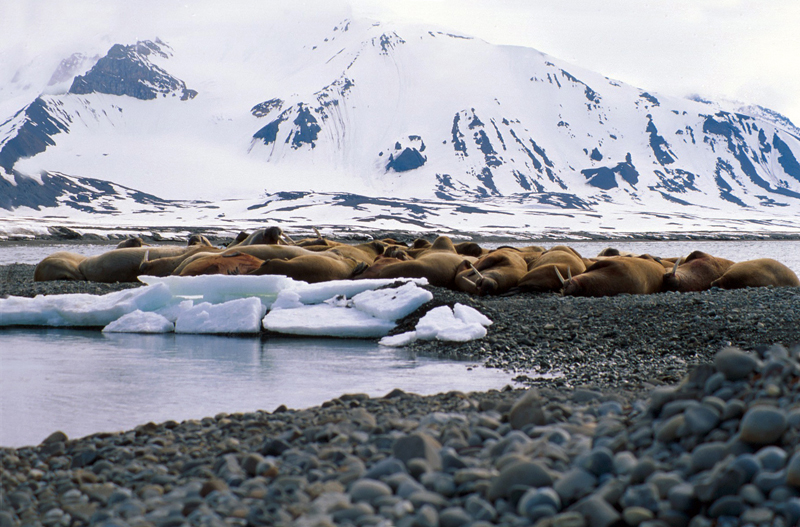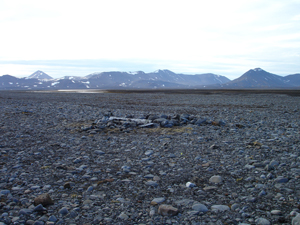Richardlaguna
By Øystein Overrein (ed.), Jørn Henriksen, Bjørn Fossli Johansen, Kristin Prestvold
The lagoon of Richardlaguna is a characteristic landscape in the north-eastern part of the island of Prins Karls Forland. The sand banks separating the lagoon from the sea constitute one of the largest haul-out sites for walrus in Svalbard. Close to the lagoon are also remains of old hunter/trapper cabins from the Norwegian overwintering trapping at the start of the 20th century, and graves from the whaling period in the 17th and 18th centuries.
 A large group of male walruses gathered on the sandy banks in front of Richardlaguna. (Image: Kit Kovacs & Christian Lydersen / The Norwegian Polar Institute) Take care:
- Keep your distance so as not to disturb walrus on land.
- Do not touch the whalers’ graves.
 Dutch whaling grave with three parallel buried coffins at the headland of Heemskerckneset, north of the lagoon of Richardlaguna on the island of Prins Karls Forland. The coffin that appears closest in the picture has been burst by the frost, and the stones that initially covered the coffin have been displaced. (Image: Lise Øvrum / The Governor of Svalbard) Dutch whaling grave with three parallel buried coffins at the headland of Heemskerckneset, north of the lagoon of Richardlaguna on the island of Prins Karls Forland. The coffin that appears closest in the picture has been burst by the frost, and the stones that initially covered the coffin have been displaced. (Image: Lise Øvrum / The Governor of Svalbard)
On the north-eastern side of the island of Forlandet, just north of the point of Murraypynten and the reef of Forlandsrevet, lies Richardlaguna. Richardlaguna is an approximately 7 km long and 2-3 km wide lagoon within large sand banks separating it from the bay of Ferskvassbukta and the sound of Forlandsundet. South and north of the lagoon are large strandflats/plateaus (old seabed). In from the lagoon the terrain is relatively flat for some distance before mountains rise up to 400-500 m. The chain of mountains is intersected by several pronounced valleys – Niggdalen, Sutordalen, Glenmoredalen and Glenbegdalen, all oriented in an east-west direction. There are several small ponds on the strandflat surrounding Richardlaguna.
Richardlaguna is well-known as one of few haul-out sites for walrus along the western coast of Svalbard. Easily accessible from Ny-Ålesund, it is often visited by tourists on cruise ships, tourists travelling by small boats, and people from Ny-Ålesund. The number of walruses here varies throughout summer, but can reach 50-60 animals at its best. Early in the season, ringed seals are also found on the ice in the lagoon.
Vulnerable elementsMale walruses are robust, but respect the animals and avoid creating uneasiness within the group, so that the animals don’t enter the water. Follow the advice below when near walrus haul-out areas:
- Walruses may be sensitive to traffic from boats and people. Observe the animals with binoculars at a distance to check if the group is calm.
- Do not drive boats close to the shore off the haul-out site.
- Landings by small boats should take place at least 300 m to the leeward side of the group.
- Divide the tourists into small groups (maximum 25 persons) and inform the group of routines in advance. Directions from the guide must be followed.
- Do not approach the animals from different directions.
- Avoid creating a skyline against the horizon.
- Keep noise down. Limit orders, conversations and engine noise to a minimum.
- The group should move slowly and jointly towards the walrus group.
- Keep the tourist group together; do not create a semicircle around the walruses.
- If there are only males in the group, they are usually more tolerant of human presence. It is possible to approach the males at a distance of 30 m, at a minimum. Keep a much greater distance from groups with females and young – minimum 150 m. These distances also apply to walruses on ice-floes.
- At the first sign of uneasiness in the group (even if the distance is much more than 30 m), stop and return to where you came from.
- Never get between the group and the waterfront, which will block the retreat of the animals and make them anxious.
- Do not approach swimming walruses or walruses on ice-floes. The animals may get annoyed and the situation could become dangerous.
The area also has cultural remains from the whaling period. Among other things, there is a triple grave from the Dutch whaling times at the headland of Heemskerckneset. Landing sitesThe choice of landing site should be based upon the location of the walruses, so as not to disturb the animals. The wind direction is also important. It is often best to enter at the mouth of the lagoon and land on the inside of the northern neck of land/sandbank or south on the flat of Sildresletta. Due to low water in the lagoon one should always go in around high tide and get out before low tide.
|